It was a day on the range with three classic and regal rifles: A .22 Hornet Winchester Model 43, a Winchester Model 70 chambered in .300 Weatherby Magnum, and a .416 Rigby Ruger Model 77 RSM Express. These are rifles that can handle everything from rabbits to rhinos, although my only intent was to punch holes in paper, preferably with the holes as close to each other as possible. It’s always fun doing so, and it’s even more fun when the rifles have an elegance rooted in fine walnut, hand-cut checkering, and deeply polished blue steel. To me, these things are art. Art you can take to the range and enjoy. I’m going to tell you more about the load data for each of these rifles in subsequent blogs; today, it’s a bit of history about the guns and their cartridges, and how I came to own each of these fine rifles.

The rifles? I’ve mentioned at least two of these in ExNotes blogs before, but for those of you who haven’t read those posts, let me bring you up to speed. The first is a Winchester Model 43 Deluxe manufactured in 1949.

The next is an early 1980s Winchester Model 70 XTR. It’s one of a very small number of rifles Winchester chambered in .300 Weatherby that year.

And the last is a Ruger Model 77 RSM Express. It’s a monstrous rifle, chambered for a cartridge designed to slay monsters. Rhinos, elephants, and more. It’s a beautiful firearm.

As I wrote this blog, I realized that I purchased all three rifles from the same store: Turner’s in West Covina, California. Turner’s is the major hunting and fishing sporting goods chain here in California. I’m usually not a fan of big chain stores, but I’ve found some good deals at Turner’s and I’ll give credit where credit is due: Turner’s did good by me. All three of these rifles were fantastic deals.
People ask how I find guns with great wood. Part of it is I’m picky and I’m patient. Another factor is that today’s firearms market is dominated by folks who want black plastic rifles and pistols. That’s the market Turner’s serves and that’s good for me, because when collectible firearms with blue steel and walnut come into Turner’s they tend to sit for awhile. Most guys who focus on ARs tend to ignore what, to me, is the good stuff.
The Winchester Model 43 was on the consignment rack at Turner’s several years ago. It was the first Model 43 I had ever seen and I liked the look and feel. I like the cartridge, too. Turner’s had the rifle priced at $1000 and after doing my research, I thought that was fair. But I’m not interested in a fair deal. I want an exceptional deal. I visited that store every week or so for a good month and a half, and that little Model 43 had not moved. You see, in that neighborhood, there isn’t much of a market for a collectible Winchester. Like I said above, it’s just not what sells around here.
Winchester only made the Model 43 from May 1948 through 1953, and as mentioned above, mine was manufactured in 1949. When I bring my Model 43 to the range, folks who know what they’re seeing are all “ooohs” and “ahhhs,” as the crowd I run with consists mostly of guys who started driving when Eisenhower was in the White House. These guys get it.
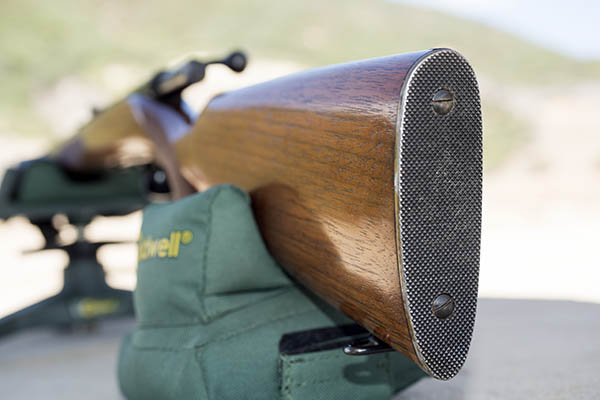


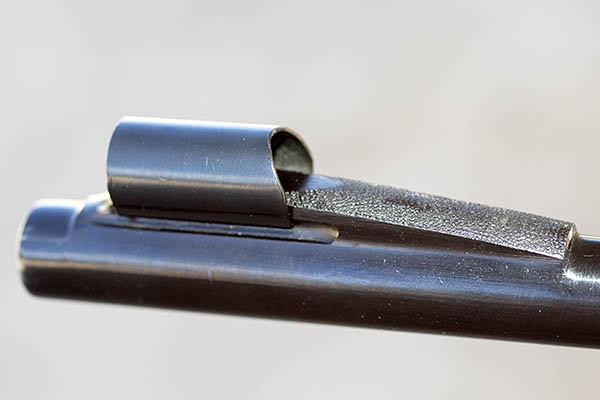
So, back to my pining over the Model 43. I stopped in at Turner’s for maybe the sixth time to look at the Hornet again. I mean, the thing was on my mind. I was thinking about it at night when I went to sleep, it kept me up, and then when I finally dozed off, I was still thinking about it the next morning. To be a complete human being, I realized, I needed that Model 43. I suspect that if you’re reading this blog, you understand.
If the Hornet was still on the rack at Turner’s, I reasoned, the guy who had it on consignment might be willing to negotiate. I was going to offer $950. The rifle was easily worth the $1000 they were asking for it; $950 would be a killer deal. So I stopped in on the way home one day and asked to look at the Hornet again. I sensed that the guy behind the counter (the Turner’s gun department manager) was a little hesitant to show it to me, but he handed it over after opening the bolt.
I looked at the attached tag. The price had been reduced to $850.
I’ll take it, I said. The gunstore guy sighed. He told me he had wanted to buy the rifle (he was an older guy, like me), but that wasn’t my problem. I filled out all the paperwork, and 10 days later, I took my 1949 Hornet home. I was a complete human being. I could sleep now. All was well with the world.
I have no idea why Winchester stopped making these rifles, but I suspect it was because they were expensive to manufacture and the Winchester Model 70 was selling better. Whatever. And the cartridge itself? The .22 Hornet was first fielded in the early 1930s and when it hit the market, it was a sensation. It was a wildcat cartridge designed at the Springfield Arsenal and its focus was high speed (in those days, the 2400 fps Hornet was fast). The Hornet’s low recoil, relatively flat (for the day) trajectory, and accuracy made it the hot ticket for sending critters to the Great Beyond. I’ve been with Hornet-armed guys chasing jackrabbits and coyotes in west Texas; there is no better cartridge for this kind of hunting in the desert surrounding El Paso. There are more powerful .22 centerfires available today, but the Hornet is the one that started it all. It’s one of the world’s all-time great designs.
Winchester offered the Model 43 in two flavors – the Standard and the Deluxe. My 1951 Stoeger catalog shows that a new Deluxe sold for $66.95 that year; the Standard was $12 less expensive. Mine is a Deluxe, with checkering and a deep blue highly polished finish. And wow, it does its job well. It has iron sights, and I shot some amazing groups with it at 50 yards. I’ll share the load data with you in a subsequent blog.
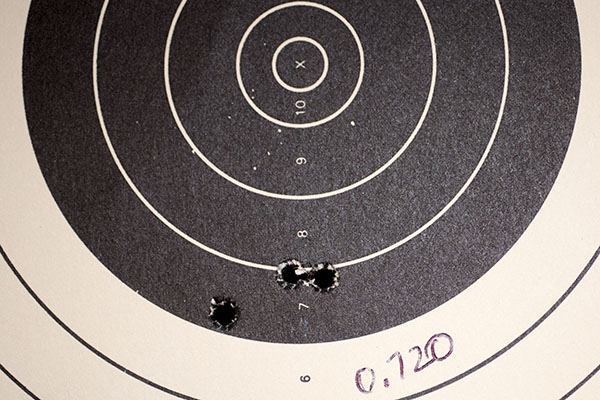
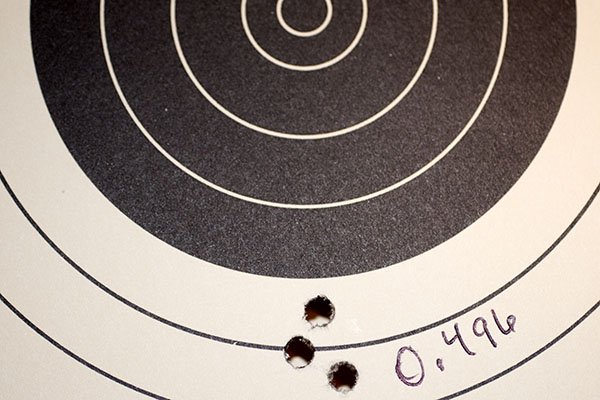
I bought the Model 70 .300 Weatherby rifle in the 1980s. I was an aerospace engineer working at Honeywell in Covina (we did naval gunfire control systems for one of the first cannon-launched laser-guided munitions), I met my wife Sue when I worked at Honewell, and I hung out with my good buddy Ralph. Ralph, as it turns out, had the same affliction as me: He was a gun nut. Ralph told me about Turner’s. I was new to California, and I had never heard of Turner’s.
You can guess where this story is going. I went to Turner’s on my lunch break and I saw the Model 70. I knew enough back then to know that a factory Model 70 chambered for a Weatherby round was an unusual rifle, and I also had a taste for fancy walnut (my Dad made custom gunstocks, so I guess the walnut thing is genetic). The rifle was marked for something like $429 or $439 if I recall correctly (I might be off a little, but it was somewhere in the just-north-of-$400 range). I knew that it was tough to lose money on a gun (not that I had any plans to sell it), but it was the wood on that Model 70 that cinched the deal for me. I paid what they were asking because I wasn’t much of a negotiator back then. Today, I know that gun shops always put the rifles with the most beautiful wood on display. By definition, that’s the one I want and I’ll work hard to get it. But now I always ask for a discount no matter how stunning the stock is, because, you know, it’s the display model. Don’t laugh. It almost always works.
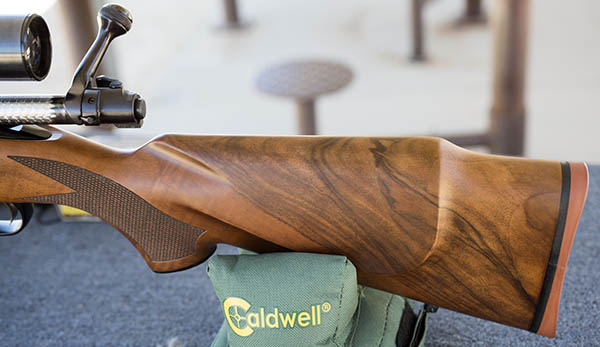
Winchester introduced the Model 70 in 1936. They value engineered the Model 70 in 1964 (that’s a nice way of saying they cheapened its looks and feel), and the pre-64s used to be far more desirable. But that’s all changed. I’ve owned pre-64s and modern Model 70 Winchesters, and I can tell you from personal experience the current production Model 70s are better guns. You can argue the point, but like I’ve said, I’ve owned both, and you won’t convince me. I’ve got the targets to prove it.
The funny thing about this particular Model 70 is that after I bought it, I didn’t shoot it but once or twice over the next 35 years. I was happy just knowing I owned it, and truth be told, I was a little intimidated by the .300 Weatherby cartridge. Yeah, I know, real men don’t flinch, but let me tell you, those .300 Weatherby rifles kick. I started getting serious about mastering this cartridge recently, though, and that’s what led to my Three 300s blog a couple of weeks ago. I guess I’m getting used to the recoil (a .300 Weatherby will rattle your fillings), because on this most recent range visit, the Model 70 graced me with a couple of 100-yard groups I found astonishing. I can’t do this with a .300 Weatherby all the time, but when I do, I’ll brag a bit. And I did. And I’m bragging a bit.
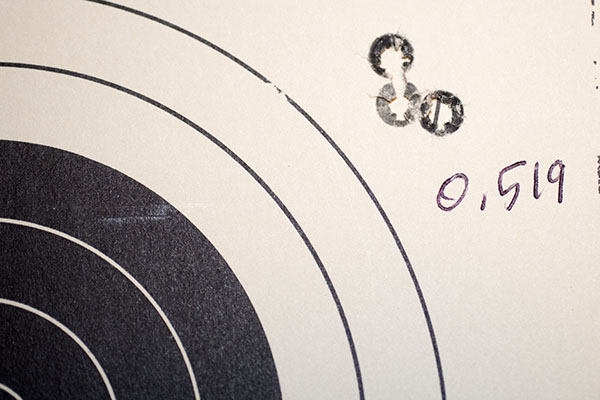
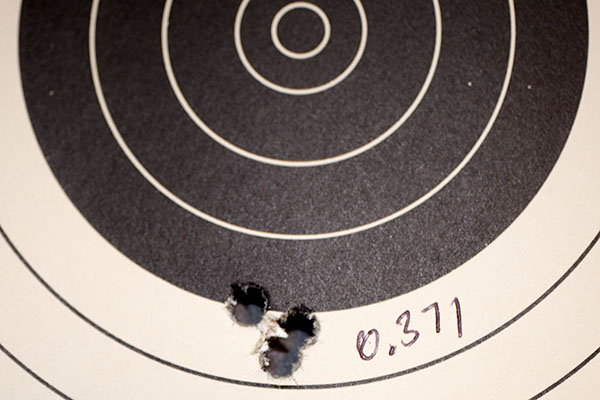
The Model 70 Winchester has been called the Rifleman’s Rifle, and for good reason. Model 70s have the right look and they are just flat accurate. I guess you could go wrong with a Model 70, but I never have, and I’ve owned a few over the years. And the .300 Weatherby cartridge? There’s no question: It’s a bruiser. Developed by Roy Weatherby in 1944, it’s still one of the fastest 30-caliber rounds ever and as you can see above, it can be very accurate.
All right, on to the last one, and that’s the .416 Rigby. Wow, what a cartridge that monster is. It was the third rifle I brought to the range with me. I was about five bays away from the rangemaster when I fired the first round. He immediately came over to ask what I was shooting. I thought he was intrigued by the thump (something that might have registered on a Richter scale somewhere), and I guess in a way he was. I proudly answered that it was a .416 Rigby. Then he asked me to move further away from his observation post. The further the better, he said.
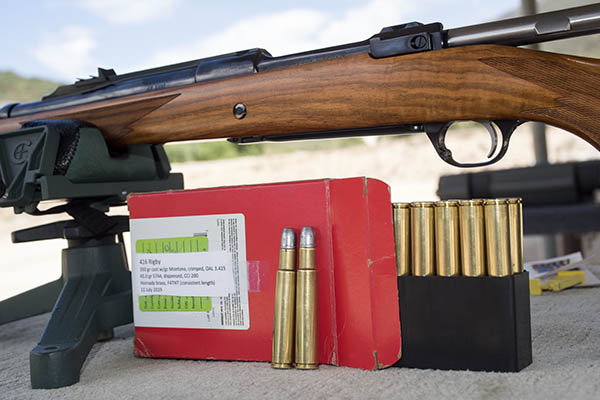
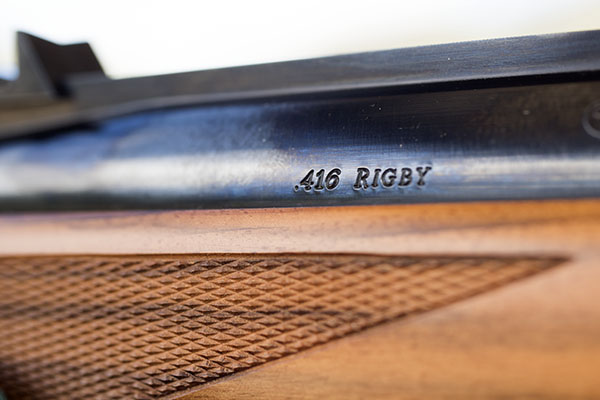
The .416 Rigby is a cartridge with an interesting pedigree. It was first developed in 1911 by John Rigby and Company, the folks in England who made safari rifles for folks who liked to throw money around. The cartridge was designed for dangerous game…big things that can bite you, stomp you, gore you, and maybe even eat you. Over the years, Rigby built approximately 500 rifles chambered for its mighty .416 cartridge, and then it fell out of favor after the .458 Winchester Magnum entered the market. The .416 Rigby probably would have died a graceful death had Ruger not stepped in with their .416 Rigby Model 77 RSM (the rifle you see here) nearly 30 years ago. All told, Ruger built about a thousand of these rifles from 1991 to 2001. Then, presumably because of the manufacturing expense and fewer guys going to Africa to chase the things that bite back, Ruger discontinued the rifle.
I bought the Ruger at Turner’s, and it was a repeat of the Hornet story. The Rigby was on consignment (at the very same Turner’s in West Covina), and it was marked $1400. That was not a bad price, and these Ruger Express Magnums are an investment (you see them now for numbers approaching $2000, sometimes even more). I keep telling my wife that (you know, the line about collectible guns being investments and all). She keeps asking me when I’m going to sell.
Like the Model 43, the barrel and sight are machined from one blank (it’s the rear sight on the Ruger rifle). That means Ruger had to hog the whole mess out of a single piece of steel. Think excessive machine time, and think high manufacturing cost.

This .416 Rigby Ruger had an exceptionally well-figured Circassian walnut stock. All of the Ruger RSM Express rifles had Circassian walnut, but I’ve only seen a few as fancy as this one, and when I saw this one, I knew I had to own it (it’s a disease, I know). And this is another rifle in as-new condition. I can guess what happened…somebody bought it dreaming of Africa, the trip never materialized, the prior owner found out what .416 Rigby ammo costs (north of $200 for 20 rounds of factory ammo), the guy fired one or two rounds and felt the wrath of Rigby recoil, and shortly thereafter the rifle found its way to the consignment rack. It happens more often than you might imagine.
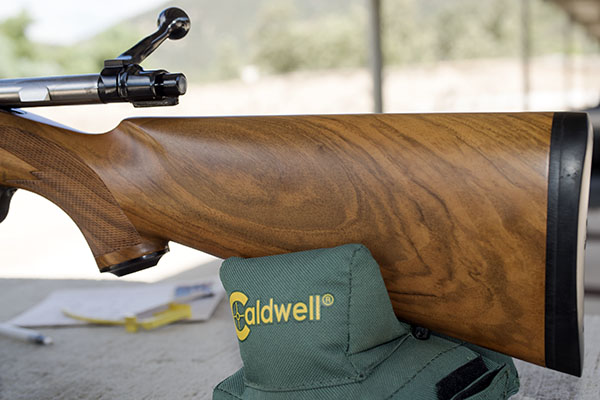
I offered the Turner’s dude $1200, and he said he couldn’t do that without talking to the person who had the rifle on consignment. I looked at him and he looked back at me for several seconds. I guess it was a standoff. Finally, I spoke: Give the guy a call, I said.
He did, and yep, 10 days later the big Ruger came home with me. It’s a monster. It weighs more than any rifle I own, and a big part of what drives the weight is that monstrous hogged out .416 barrel. But when you light one off, that weight is your friend. It soaks up the recoil, of which there is plenty.
The Ruger was not nearly as accurate as the other two rifles I had on the range that day, but it still wasn’t too bad. I was shooting at 50 yards initially, and this is the best group I could get…
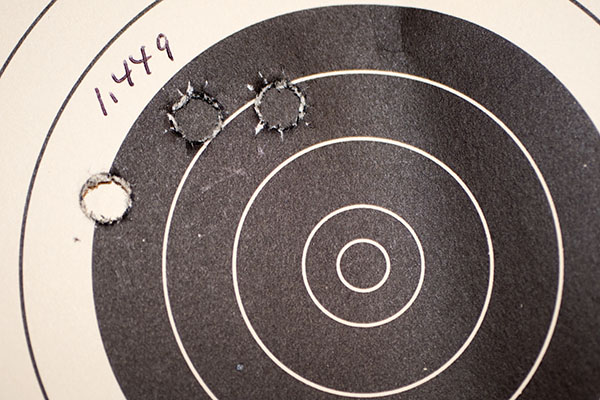
After shooting five 3-shot groups at 50 yards, I had five rounds left in the box of 20. I wanted to see where the bullets would hit at 100 yards, and I used a pistol silhouette target to make that assessment.
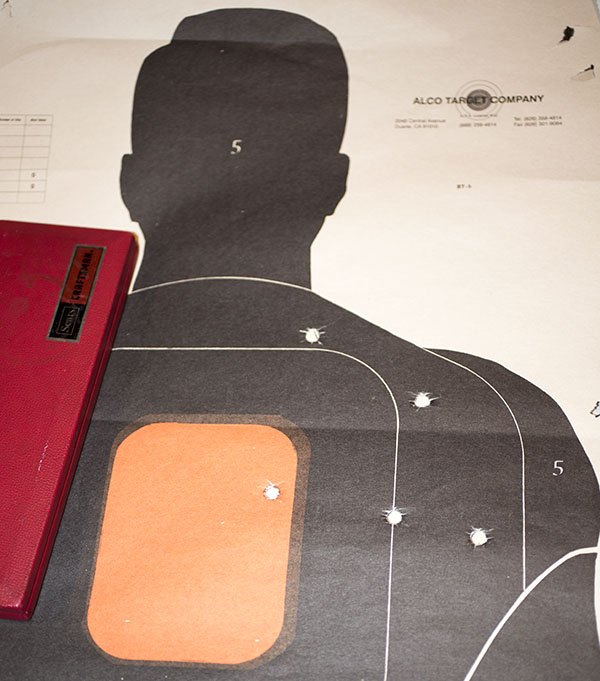
I held at 6:00 on the target’s orange center, and I used that larger target because I didn’t know where the rounds would land at that distance (I wanted lots of paper around the point of aim so I could see what was going on). I put all five shots on paper, but the group size was a disappointing 6.6 inches. Oddly enough, the rifle was printing very slightly to the left at 50 yards, but it clearly grouped to the right at 100 yards. I need to think about that a little bit. Maybe it was the way the sun was hitting the front sight (that can make a significant difference), as I shot the 100-yard group later in the day. I found the v-notch on the Rigby’s rear sight to be a bit difficult to use (I could not form a consistent sight picture). I guess it’s okay for a charging rhino, but it’s not conducive to the accuracy I sought. I’m not done with the Ruger Express rifle yet, and truth be told, I ‘m kind of glad the results weren’t stellar. Half the fun with these things is searching for the perfect load. Once you find it, for me at least, a lot of the excitement goes away. I figure there’s still plenty of excitement left in the Rigby.
Do you enjoy our gun stories and photos? Check out our other Tales of the Gun. And don’t be bashful about adding your name to our blog update list. You can do so here:

.416 Rigby isn’t meant to do minute of angle… Minute of Rhino is sufficient.